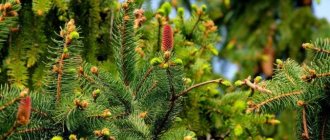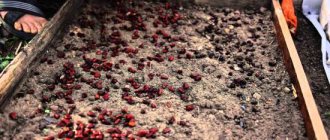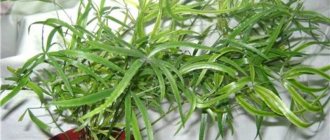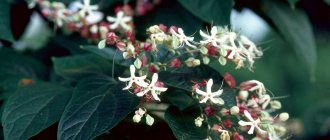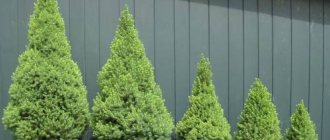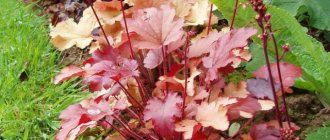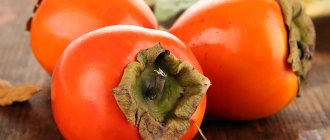There are situations when it is necessary to propagate an apple tree and other trees, or to create several varieties on one plant. At these moments, you need to use the methods of cuttings and grafting. If you know the whole algorithm, then you can easily achieve an impressive result, namely a dozen young seedlings.
Propagation is often carried out through grafting, and direct rooting is used only when a young shoot acts as the starting material.
Apple tree cuttings: is it possible to grow an apple tree from a cutting?
The answer to this frequently asked question is unequivocal - yes, you can. Moreover, this is practically the only way to propagate an apple tree. True, there is still the possibility of growing it from a seed, but this is a rather painstaking method that requires a significant investment of time. It does not preserve varietal characteristics and has not found wide distribution. The main purpose of cuttings is to obtain seedlings for propagation.
There are two methods for obtaining an apple tree seedling from a cutting - grafting onto a rootstock (this is the name of a plant to which a bud or cutting of another plant is grafted) and rooting the cutting without grafting. Let us reveal in detail the essence of the second method.
Apple tree propagation by rooting cuttings
This method is used in two main cases:
- For growing rootstocks for the purpose of further obtaining seedlings by grafting.
- To obtain own rooted seedlings.
The method consists of the following steps:
- Preparation of cuttings.
- Storing them (if necessary).
- Rooting.
- Landing in the ground.
Apple tree propagation by lignified cuttings
Lignified cuttings are usually rooted in the spring and harvested in late December - early January. To do this, select one- or two-year-old woody shoots located in the middle part of the crown on the southern or southeastern side of the tree. They must be absolutely healthy, without signs of disease or damage. Next, there are two options:
A method for stimulating the processes of concentration of hormonal growth substances in future cuttings
It has a high survival rate - according to information from various sources, it is at least 70%. The method is as follows:
- The branches are broken without damaging the bark or with partial damage. Long branches can be broken in several places at intervals of 15-20 cm.
- The fracture sites should be fixed by applying a bandage made of plaster, tape or other suitable material. In this form, the cuttings are left until spring, while growth substances will be sent to the injured areas for healing of fractures.
Places of fractures should be fixed by applying a bandage made of plaster, tape or other suitable material.
For rooting, place the cuttings in opaque containers (two-liter bottles made of dark plastic with a cut off neck work well), at the bottom of which a porous sponge 1-1.5 cm thick is placed and melted or rainwater is poured to a level of 5-7 cm
When the size of the roots reaches 5-7 cm (usually this takes two weeks), the cuttings are planted in the ground
In plant biology, callus is the name given to cells that form on the wound surface of a plant. Callus tissue, as a result of the division of cells bordering the wound, forms suberized areas - as a result, wounds heal, grafts grow together, etc.
Rooting lignified cuttings at home
From the selected branches, as described above, cuttings 10-15 cm long with two to three internodes are cut and placed for storage in a container with wet sand (the cuttings must be completely filled). The air temperature should not exceed +2 °C. They begin rooting in late February - early March. For this:
- Prepare suitable containers (boxes, containers, pots, etc.), which are filled with nutritious soil to a depth of 15-20 cm. Such soil must be prepared in the fall by mixing chernozem, peat, humus and river sand, taken in equal parts. You can also use any purchased soil with a neutral acid-base reaction (pH 6.5-7.0).
- Take out cuttings and refresh their cuts.
- The upper cuts are covered with garden varnish.
- The lower ends of the cuttings are dipped for several hours in a rooting agent solution (Heteroauxin, Kornevin, Zircon, etc.).
- The cuttings are planted in the soil to a depth of 5-7 cm (there should be no buds in the section below the soil level, and if there are, they are first removed) with an interval of 5-10 cm.
The cuttings are planted in the soil to a depth of 5-7 cm with an interval of 5-10 cm
The described method can be improved in an interesting way. Before placing the cutting in a box with nutrient soil, stick its lower end into an ordinary raw potato (all eyes are first removed from it). Then the lower part of the cutting along with the potato is buried in the soil. Further actions remain the same. According to some evidence, this technique increases the rooting rate of cuttings and they form better roots.
Advantages and disadvantages of apple tree propagation methods by rooting lignified cuttings
The advantages include the following features of the method:
- Preservation of varietal characteristics of the donor. Cuttings can be taken from both own-rooted and grafted apple trees.
- Possibility of propagation of an apple tree at any age.
- Cuttings are easy to save, they can be sent to any distance without special costs (unlike transporting ready-made seedlings).
The only drawback of the method compared to propagation by root cuttings is the longer period of rooting and obtaining a finished seedling.
Propagation of apple trees by green cuttings
This method does not provide a high survival rate - according to various sources, it ranges from 30 to 60%. But since green cuttings can be prepared in fairly large quantities, and completely free of charge, you can always end up with the required number of seedlings. Another advantage of the method is the preservation of the varietal characteristics of the donor. The disadvantages include somewhat troublesome care and a longer period of obtaining a finished seedling - it is two years. Because of these shortcomings, the method is rarely used in practice. For those who want to try it, we will describe it in detail. You should start the procedure from the beginning of May to the end of July, but the sooner the better.
- Immediately before planting, preferably early in the morning, cut the green branches of the current growth.
- From each branch, depending on its length, you can cut one or more cuttings. Each of them should have three buds. In this case, the following rules are observed:
- The bottom cut is made directly under the bud, and the bottom leaf is removed.
- The upper cut is made 0.5-1 cm above the kidney.
- In order to reduce moisture evaporation, the remaining two sheets are shortened by half.
- A layer of nutritious soil 5-7 cm thick is poured into a low box, and above it - wet sand in a layer of 4-5 cm.
- The prepared cuttings are stuck into the sand to a depth of 1-2 cm. The distance between the cuttings is maintained within 4-5 cm.
Green cuttings are stuck into the soil to a depth of 1-2 cm at intervals of 4-5 cm
Video: how to properly root green cuttings
Growing apple tree seedlings from root cuttings
You can propagate any variety of apple tree using root cuttings. The only important thing is that it is rooted. If we take cuttings from a grafted apple tree, the result is an unvarietal seedling that can only be used as a rootstock for grafting a cultivated variety onto it. The second condition for obtaining a positive result is that the donor apple tree must be young (no older than 5-7 years), since with age its ability to form root shoots sharply decreases. Cuttings are prepared in the fall by cutting parts of roots with a diameter of 5-10 mm and a length of 10-15 cm, not forgetting to mark their ends, which were closer to the trunk. Until spring, the cuttings are stored under a layer of sand in the cellar at a temperature not exceeding +5 °C. You can also dig cuttings in the garden. To do this, a small ditch is dug in a non-flooding area, with a layer of sawdust placed at the bottom. The cuttings laid on top are also covered with sawdust and sprinkled with earth. If the winters in the region are cold and have little snow, then the digging area is additionally insulated with available materials - spruce branches, dry leaves, sawdust, etc. It would be a good idea to put poisoned mouse baits in the storage area.
Planting begins in early spring when the buds begin to swell. The technology is as follows:
- 10-15 days before the expected planting date, place the cuttings obliquely in a box with sawdust so that the part that was closer to the trunk is covered, and the second part is directed upward and protrudes slightly above the sawdust.
- The sawdust is well moistened and the box is placed in a warm room (+20-25 °C).
- After some time, buds form on the cuttings, after which the shoots begin to grow. When the primordia of shoots reach 1 cm, they are planted in the ground. This usually happens within 2-3 weeks.
- The cuttings are planted obliquely or vertically in grooves at intervals of 5-6 cm to such a depth that they protrude from the ground by 1.5-2 cm.
- The furrow is watered and mulched.
- After the emergence of seedlings, they are cared for in the same way as ordinary seedlings (watered, loosened, weeded, shaded, etc.).
Some time after planting the root cuttings, shoots appear
The main advantage of the method is the shorter time to obtain a seedling than when rooting a lignified (and even more so green) cutting. But you can get a seedling even faster (and with the same quality result) by using a root shoot (shoot) as it. Disadvantages of the method:
- Inability to reproduce grafted trees.
- Inability to reproduce old trees.
Growing seedlings from root cuttings
In the spring, soil is poured around the trunk in a layer of 20 cm and watered constantly throughout the season. The next year, roots with shoots grow from the sprinkled area of the trunk, which are cut off and used for propagation. Of course, this method is only applicable to rooted apple trees.
The next year, after sprinkling the trunk, roots with shoots grow from it, which are cut off and used for propagation
Video: obtaining apple tree seedlings from root cuttings
Rooting cuttings on a tree (air layering)
Quite an interesting method of growing roots directly on a tree. For the purposes of this method, in May - June, the strongest branches with good growth are selected. Then do this:
- They find a young shoot of the current year and, below the place where it began to grow, on last year’s woody part, remove the bark in a ring 1-3 cm wide.
- The cut area of the bark is moistened with Kornevin’s solution, which will promote faster root formation.
- At a distance of 10-15 cm above the incision, all the buds are blinded and several cuts are made in the bark.
- A narrow plastic sleeve is placed on the branch - a bag with a cut bottom - with a diameter of 10-15 cm. Its lower end is secured with electrical tape below the annular cut by 7-10 cm. After which the bag is filled to the height of the blinded buds with damp rotted sawdust or wet moss and add a little humus . Moisten the substrate by adding approximately 200-300 ml of water - melt or rain - and secure the upper end of the bag with electrical tape. Instead of a bag (or together with it), you can use a cut plastic bottle of a suitable size.
The structure for rooting airborne layerings is made from scrap materials
This ancient method, although not widely used, has practically no drawbacks and can be recommended for use.
Video: rooting air layering of an apple tree
Propagating an apple tree by rooting cuttings seems difficult only at first glance. By carefully studying the instructions for obtaining seedlings from woody, green or root cuttings, the gardener will find the most suitable method for a particular situation.
Preparation
The procedure for propagating an apple tree at home is carried out only after preparation. First, the tree is inspected for diseases and damage. If signs of disease are detected, the apple tree is cured.
After this, the material is prepared with the help of which reproduction will be carried out. It is impossible to prepare a large amount of material at once, so that it does not disappear. If you decide to propagate an apple tree using cuttings, you need to remove all the leaves from it.
When working, use only sterilized tools to avoid infecting the tree. To do this, use special chemicals (copper sulfate or “Crisp”) and folk remedies (potassium permanganate or ammonia). The preparations are diluted according to the instructions so as not to burn the material during work, but to remove all bacteria and fungi.
You will need:
- 2 liter plastic bottle;
- large plastic bag (up to 40 cm long);
- substrate.
Garden soil, humus or sawdust are used as a substrate. You can mix manure with compost or soil with vermiculite in a 1:1 ratio. Its properties help it retain moisture in the soil.
Good germination of seedlings is observed if sphagnum is used as a substrate. Don't forget to water it every few days.
Periodically, the substrate is replaced with ready-made cotton wool cubes for hydroponics. Due to its sterility, it is used several times per season. Do not forget to regulate the moisture level of the cotton wool, because... otherwise it will lose its beneficial properties.
Types of moisture-intensive materials for air layering on an apple tree
If you have a question about how to propagate an apple tree by layering, then:
- Requires a 1.5 liter plastic bottle.
- Polyethylene sleeve.
- Special substrate.
The substrate is made:
- From moss, garden soil, ready-made compost, rotted sawdust.
- A substrate of 1 part rotted manure and 1 part humus.
- Substrate made of earth and vermiculite , since vermiculite retains moisture well. In addition, vermiculite contains all the nutrients necessary for the culture: oxides of magnesium, silicon, potassium, iron, calcium, etc. But do not add mineral fertilizers to the mixture.
- You can simply use sphagnum moss, constantly moistening it.
- You can buy special mineral wool for hydroponics in the form of cubes. It has several advantages. It is sterile, that is, harmful microorganisms do not form in it. It has a long service life and can be used several times. It has elastic fibers, which allows the roots to grow normally and receive oxygen. But you need to constantly moisturize it, preventing it from drying out.
The substrate must be constantly moistened.
Cuttings
To propagate an apple tree using cuttings, they are first harvested. The right time for this is spring or autumn. If you prepare the material in the summer, it will produce roots faster, because... I didn’t have time to get stiff. Try to take cuttings from the bottom of the tree. They will form roots faster.
The best cuttings are the current season's growth that appears in the spring. The older the material, the more difficult it is to work with. The denser the inner layer of wood, the more likely it is that the cutting will break and it will be impossible to carry out further actions.
Scheme
Step-by-step instructions for growing apple trees from cuttings will help you carry out the process correctly:
- cut cuttings, the size of which is 10-15 cm, in the morning. At this time, more moisture accumulates in them. Take a few spare cuttings at once;
- Pour “Kornevin” (40 g per 6 liters of water) over the cut branch to speed up the formation of roots. After this, it is placed on the windowsill, dipped in a vase with warm water. Under the influence of water and sun, roots will appear on the cuttings within a few weeks;
- when the roots on the branch are 8 cm in size, it is prepared for planting in open ground;
- plant cuttings using the group trench method. Dig and saturate the trenches with fertilizers in advance. The smaller the distance between the bushes, the greater the chance of getting a healthy apple tree.
When the cuttings are completed, they begin caring for the crop. Water it every 14 days so that the soil does not have time to dry out. Loosen the soil in the tree trunk every week. This way you will improve access to the roots of air and nutrients. To reduce the likelihood of moisture evaporation from the soil, mulch the tree trunk circle with straw and rotted manure.
The advantages of cuttings include the possibility of obtaining plants that will be used for grafting, performing the functions of a rootstock, and the constant renewal of productive apple varieties.
The first drawback is that summer apple tree cuttings do not always reach the rooting stage and the gardener will have to repeat the procedure, spending time and effort. The second disadvantage is the impossibility of carrying out actions in the spring or autumn. Only in summer can a gardener take cuttings from an apple tree.
More information about vaccination
Preparation for grafting begins with choosing a rootstock , which can be a wild (self-grown) apple tree or one planted from seed. The first option is preferable due to stability.
The grafting is carried out to the root system of the rootstock, if it is not planned to form several varieties on one apple tree. should be selected as a scion . Cuttings of an apple tree in summer are carried out on the day of cutting the cuttings , after removing the leaves and leaving the petioles.
ATTENTION! Using dormant cuttings for grafting is considered a more productive option than using fresh material. To do this, shoots are harvested in late autumn (November) - winter (before severe frosts). For storage, the cuttings are placed in a cellar or buried in the snow.
By layering
This method is used in early spring, after the snow has completely melted. The soil should still be cold and moist. For layering, adult branches (2-3 years old) with a diameter of 2-3 cm are used. Choose only those that have been in the sun for a long time and do not have branches.
Due to the fact that the air layerings are only half lignified, there is a small green growth on them. In the place where leaves have not yet formed, wrap the branch with plastic wrap. Secure everything with electrical tape and leave it until the end of spring. The heat will soften the branch.
At the end of May, the film is removed and cuts are made. It is better to do them at the junction of age-related shoots and young growth. The width of the first annular cut should be 10 mm. 2 more cuts are made on either side of it. If fruit buds appear, get rid of them.
Scheme
Rooting air layering occurs as follows:
- the prepared substrate is poured inside any container suitable for planting;
- cut off the bottom of the plastic bottle, and wrap the lower part of the branch with polyethylene and electrical tape;
- the inside of the bottle is treated with “Kornerost” or “Kornevin”;
- the branch is placed in a container with a substrate and covered with a cut bottle - this will allow rooting to occur faster;
- the entire structure is placed in a shaded place in order to root the tree more reliably.
Caring for air layering involves weekly watering. A month before planting the branches in open ground, dig a hole and feed it with humus. The seedling is placed inside along with a ball of soil, removing it from the container. The first fruits will be formed in a few years: 3 years should pass.
Branch selection and preparation
How to propagate apple trees and other fruit trees by air layering?
First we need to choose a branch that will become our future seedling. It should be healthy, fruitful, without branches, well lit by the sun. Ideal for this case are two- or three-year-old branches, half woody with fresh growth (it differs in color from the main branch, it is greener). The branch should be about the thickness of a pencil. In the spring, after the snow has melted, when the leaves have not yet blossomed, we put a sleeve of transparent film 35-40 centimeters long on a pre-selected branch. We attach both ends of the sleeve to the branch with electrical tape. When the air temperature rises (in May-June), a greenhouse effect will occur under the film. The bark will become softer, which means that all subsequent manipulations will be easier.
We remove the film from the branch, find the boundary between last year's growth and the main branch, retreat from this boundary 10 centimeters towards the trunk and make a circular cut, that is, remove a centimeter of bark along the ring. Now we make four more cuts on the bark on both sides of the ring: two towards the trunk, two towards the top of the branch. You can make cuts only on one side, you can not make them at all - whatever you like. But with cuts, the root formation process will go much faster.
We remove all fruit buds above the cut ring. The branch is now ready to become a cutting.
Broken branch method
Various vaccination methods
The apple tree propagation method called the broken branch method is used both in spring and autumn. Propagating an apple tree by cuttings at home is not entirely correct. A better and more progressive method is the broken branch method. The main goal is to create an artificial stimulus for root formation in trees.
Scheme
The technique consists of performing 7 simple steps:
- In winter or early autumn, they select a one-year-old shoot on a tree and break it. The bark must not be cracked, otherwise it will not be possible to grow a healthy apple tree;
- fix the branch in this state using wire and electrical tape;
- at the end of March or November, the electrical tape is removed, and the upper part of the shoot is cut off from the mother tree with a knife;
- several lateral buds are left in the lower part and the old apical bud is cut off (formed at the very top of the shoot, representing a new bud);
- cut off the neck of a dark plastic bottle, pour 300 ml of water inside and throw in 3 capsules of activated carbon;
- cuttings that were prepared using the broken branch method are dipped in a bottle and placed in a well-lit place (balcony or window sill);
- After 3 weeks, roots will appear. When their length exceeds 5 cm, the seedling is placed in open ground. If the procedure is carried out in the fall, planting is carried out in December, first in a bucket and placed on the balcony. Planting in open ground is carried out in April.
What is cloning method
Cloning plants has become very fashionable in recent years. Even novice gardeners use this method. This is due to the fact that not all varieties can be propagated by layering. The method is similar to division using offspring. It is recommended to select them and pre-plant them. Cloned seedlings take root quite easily. Flowering in this case begins already in the fourth year. Fruiting in cloned trees is usually abundant. The easiest way is to use branches that are as low as possible. You can place a container with fertile soil under them, pin them down and cover them with earth. In advance, part of the bark should be removed from the branch and treated with a root formation stimulator. In this case, you will get a cloned layer that will exactly repeat all the “parental qualities”.
Cloning is generally used by industrial breeders and is increasingly being used in agriculture.
On a note! This method is increasingly used on an industrial scale. But for these purposes, cellular tissue should be used.
With your eyes
Vaccinations have increased sensitivity to bacteria, moisture and dust that enter through the wound. To prevent this from happening, follow certain budding rules. It is carried out in the spring, before the bark of young branches has time to become woody.
Scheme
Carrying out the process at home will not take much time and effort:
- inspect the mature tree and select a suitable rootstock. A small T-shaped incision is made in its lower part;
- The top part of the bark is pulled back, exposing the inner wood. A cutting of an apple tree containing buds and bark is inserted into the cut. Its size should be 2 cm;
- the previously removed rootstock bark is leaned against the attached bud;
- tie the bark to the trunk without capturing the bud;
- After a week, the seedling is examined for survival. If the eye is green, the budding was successful and you will be able to grow a healthy tree.
It is better to propagate an apple tree with eyes in the morning or evening. The sun should not be allowed to enter the cut. If propagation is carried out in the spring, the probability of survival will be 15%. In autumn it reaches 70%.
The advantage of budding is the formation of several crowns on one trunk. The disadvantages are that it is impossible to carry out actions during rain or heat; it is inappropriate to carry out work in the spring, because in the fall the chances of survival are higher.
Timing and features of apple orchard propagation work
To grow healthy fruit trees, rejuvenate old ones, and breed new varieties, certain procedures are performed on the site each season.
in winter
In the coldest period of the year, they shovel snow up to the tree trunks and whiten the trees if they didn’t have time to do it in the fall. At the end of February, experienced gardeners begin pruning.
In summer
In July and August, apples ripen, and it’s time to harvest and prepare the harvest. This season, only dry and damaged branches are removed; healthy shoots are not shortened, but pinched to limit growth.
in spring
Most work occurs in March and April. The garden area is cleared of debris and the soil is loosened. Until sap flow begins:
- form a crown;
- carry out maintenance pruning;
- Spray the trees with Bordeaux mixture.
To whitewash the trunks, mix chalk, casein glue, and copper sulfate. Fertilizers containing nitrogen are applied to the soil.
other methods
There are several other methods by which fruit trees are propagated. You can grow new seedlings using seeds. This method is used in the spring. It is used if they want to develop a new apple variety.
To propagate an apple tree by seeds, in the fall they are removed from fruits of different varieties and washed under running water. After this, they are treated with Epin (400 g per 5 liters of water), a strong growth stimulant. After this, the seeds are placed in small grooves to a depth of 1 cm.
The distance between seeds should be within 15 cm. To propagate apple crops by seeds at home, the planting material is hardened. To do this, place them in damp sand and the refrigerator for several days. Only in spring are they planted in furrows. When the first shoots appear, seedlings with a small number of leaves are removed.
The advantages of this method of apple tree propagation include:
- preservation of varietal properties that are transmitted from the parent tree;
- improvement of product and taste qualities, because the new apple tree acquires the advantages of several varieties between which pollination took place;
- The lifespan of trees obtained from seeds is longer than after grafting.
The disadvantages include the impossibility of using the method by beginners, because it is suitable for experienced gardeners (it is often used in nurseries to obtain more resistant varieties), a long process of work (not always successful), fruiting time when compared with grafted seedlings.
Transplant method
It is carried out in early spring, 3 weeks after the snow has completely melted. In this case, root seedlings are used, which are located at a distance of 2 m from the mother tree. Choose “scions” only of healthy and fruit-bearing varieties.
In spring or autumn, seedlings aged from 1 to 2 years are dug up. Their root system must be developed. It is better to replant young trees in the fall according to the standard procedure. As a result, you will receive valuable “copies” of the apple tree, only with a low survival rate.
Grafting with an insert is carried out in the fall, a month and a half before the onset of frost. The essence of the method is that inserts of weak varieties are grafted onto the root system of a strong variety. For reliability, they are fixed with electrical tape or adhesive tape.
Advice from experienced gardeners
Experienced gardeners and all breeders advise not to neglect the following recommendations for propagating apple trees:
- It is impossible to propagate fruit crops in the spring using cuttings. They grow very quickly at this time and they do not have enough nutritional juices for normal life. That is why almost all sprouts dry out and die as a result.
- It is best to take cuttings in the summer, since it is the elevated temperature that allows the planting material to be filled with nutrients.
- On mature trees, several graftings can be done simultaneously. This will allow you to get the best result.
- The breeding season is stressful for the tree. That is why we should not forget about other ways to care for an apple tree. It is necessary to apply fertilizers in a timely manner, moisten the soil and remove all harmful insects.
Following basic tree care rules will allow you to get an excellent harvest.
Apple tree propagation requires strict adherence to basic rules. This will avoid problems in the future and prevent the development of all kinds of pathologies. Even minor errors can lead to significant yield loss and change its quality characteristics.
Reproduction methods
The apple tree is not the most capricious tree to reproduce. However, before you get down to business, it’s worth understanding what home methods exist. To be on the safe side, you can use several methods. How does an apple tree reproduce:
Propagation using seeds seems to be the simplest and most logical. However, there are difficulties: firstly, it takes longer, and secondly, you may not get the variety you expected. The fact is that when grown from seeds, trees acquire a different genetic set. Therefore, this method is used to breed new varieties. Of course, out of curiosity, you can try to germinate the seeds and get a shoot from them, but you should not rely on this option. Most likely, the result will be a wild apple tree with small apples.
The most successful methods are propagation using layering and cuttings.
Possible errors and failures
The use of low-quality material can lead to negative results. That is why it is recommended to use cuttings for propagation. This is the simplest and most convenient way to avoid a lot of mistakes. All vaccinations must take place only at a certain angle. Branched branches cannot be used. The use of transparent film for reproduction is not recommended. It is best to take black special polyethylene for these manipulations.
Attention! Another mistake that beginners often make is failure to meet deadlines for work.
New tree from a branch
The method of propagation using layering is simple if you follow the rules. There are 2 ways to grow an apple tree from a branch, both refer to propagation without grafting.
The first way is to plant a seedling of the desired variety in the fall at an angle so that the branches touch the ground. In early spring, inspect the tree, select young shoots and staple them to the ground. Throughout the summer, you need to hill up the place where the roots will grow from the bud several times and maintain the moisture level necessary for rooting. In this way, by autumn you will have completely viable seedlings. The advantage of this method is to obtain a large number of new seedlings. The downside is the need to buy a young tree. That is, it will not be possible to grow an apple tree seedling from an old tree.
Bury apple tree branches
How can you root an apple tree branch without being able to dig it down? Here a more convenient method comes to the rescue: propagating apple trees by air layering. You need to carefully examine the tree and select developed branches with good annual growth (those with shoots). You need to take it, step back about 10 cm from the top and use a sharp (this is important) knife to peel off the bark in a ring about 3 cm wide. This area is treated with a special solution that stimulates root growth. You can find one at a garden store. Dilution of the solution - according to the instructions.
Moisture is required for the formation of roots, so the place of future root growth must be wrapped in moss and covered with a bag. Throughout the summer, the bag should be removed periodically to moisten the root formation area. With the arrival of autumn, you can remove it completely. If everything is done correctly, the root system will be quite developed. Then, using pruning shears, the future seedling is cut just below the roots and planted in a permanent place. It is better to cover the future apple tree for the winter, as it is still rather weak.
Important! If there is no moss on the site, you can build something like a greenhouse on a branch. For example, make a container out of a plastic bottle, fill it with a substrate that can retain moisture (for example, rotted leaves) and secure it to a branch. The role of a container can also be played by a disposable glass or something else that is not very heavy.
Seeds
Propagating an apple tree by seeds is a very interesting way, because... allows the gardener to follow the process of growing a fruit tree from the very beginning. Children will be especially interested in growing a real apple tree from a seed. The disadvantage of this method is that not all apple trees transmit their varietal qualities through the seed.
Growing apple trees from seeds.
In the fall, when picking fruits, choose a large ripe apple and remove the seeds from it. The seeds also undergo a serious selection process: they need to be properly shaped and colored, with greenish tips. Selected seeds are washed, soaked, stratified and planted in a school.
In indoor conditions, seeds can be planted at any time of the year. Planting in a permanent place is carried out only when the seedlings reach the age of 1–2 years.
How to propagate an apple tree from cuttings
Apple trees are usually propagated using cuttings in the spring. This way, by the fall, you get seedlings with roots that can be planted in a permanent place in a couple of years.
Green cuttings
Ideal cuttings will be young shoots, the lower part of which has already begun to become woody. When all the leaves, except the top one, are already open, you can begin to work.
How to take cuttings from an apple tree:
- It is best to take cuttings in the morning. This can be done conveniently with a special sharp knife for grafting. The lower cut is not made straight, but at an angle of 45º, directed towards the kidney, without cutting it off. The upper cut, on the contrary, should be straight. Typically, an average of 3 cuttings can be obtained from each shoot.
- Each shoot must have at least 3 leaves. Moreover, the bottom one needs to be removed and the top 2 left. The remaining 2 leaves should be cut in half (with the same grafting knife).
- The resulting future seedlings should be placed in a root stimulating solution for 18 hours. It is better to cover the container in which the branches will be kept with a film or bag. This way the humidity level will be higher, which is beneficial for future roots.
- While the cuttings are in the solution, you can prepare a box for later holding the cuttings. The container should be approximately 30 cm high. It should be covered with earth to a height of 20 cm, and about 5 cm of sand on top, which must first be calcined in the oven. This is done so that all the bacteria in it die. Before placing the cuttings in the substrate, it must be moistened. You can do this with water, or you can do it with a stimulating solution.
- After the cuttings have been kept in the solution for the required time, they can be planted in a box. They should be placed shallowly in the sand, from 1 to 2 cm. If placed deeper, they may rot. When planting, you should strictly ensure that the leaves do not come into contact with each other or with the walls of the box.
- The box with cuttings should be in a warm, bright place, but not in direct sunlight. Every week you need to ventilate the cuttings and monitor the humidity. It is better to water not from a watering can, but from a spray bottle. Dampness must not be allowed. You also need to inspect the cuttings for rotting.
- If conditions are favorable, then on average within a month the cuttings will develop roots. When this happens, you can and should ventilate more often. This way, future seedlings will get used to fresh air and natural conditions.
Such cuttings need to overwinter in the same box. It is buried in the garden level with the ground, the cuttings themselves need to be sprinkled with sawdust, pine needles or peat. In the spring they are planted in a temporary place for growing. The seedlings will be ready for planting in a permanent place in 2 years. This is not the shortest period of time, but it is a successful method.
Apple tree cuttings can be done in another way in the spring: using a champagne bottle. Here the algorithm of actions is different. The shoot is cut off completely, then placed in a bottle filled with boiled water, cooled to normal temperature. The shoot is placed in a bottle, the hole is sealed with garden varnish or wax. The bottle should be placed in a hole in a well-lit place. Trim the shoot, leaving only 3 buds above the ground. Cover the top with film or place a plastic bottle with the bottom cut off. Further care is the same - ventilate and water if necessary.
Important! Apple trees are propagated by cuttings in the spring - this is a prerequisite. In 2-3 years, such a seedling should develop a good root system.
How to get a seedling from an old apple tree
In winter (no later than 2 months before sap flow), the following operation must be performed: on good branches with wood no older than 2 years, break a branch. Moreover, it is advisable to do this so that the bark remains intact. The optimal length of future shoots is 20 cm.
The broken area needs to be wrapped with grafting film, electrical tape or something similar. If possible, place a kind of splint on the branch, for example, wire. In the spring, the tree will direct its forces to heal the wound, which will contribute to the growth of future seedlings. During active sap flow, the cuttings need to be cut and placed in a dark plastic bottle filled with water (or snow) to about 6 cm. You can throw a couple of tablets of activated carbon into the water. Place the container in a warm, bright place (for example, on a window), and after 3-4 weeks you will get so-called seedlings. You can plant it outside once the roots reach 6-7 centimeters in length.
The need for cuttings
The duration of intensive fruiting of apple trees is several years, then the volume of the harvest begins to gradually decrease.
Ultimately, there is a need to renew the garden - replacing mature trees with young seedlings. Also, the process of propagating apple trees by cuttings is resorted to in order to increase the area of the apple orchard by planting young trees taken from time-tested specimens. Gardeners have the opportunity to purchase recently bred hybrid varieties with high fruiting from the nursery. However, given the unique climate in most regions of the Russian Federation, there is no guarantee that new varieties will give the expected results. To avoid such risks, most gardeners prefer planting material taken from their own plots, since their own apple trees have already adapted to a specific climate, survived many winters and demonstrated productivity.
Cuttings are the optimal way to rejuvenate the mother tree, which can be carried out almost at any time of the year.

